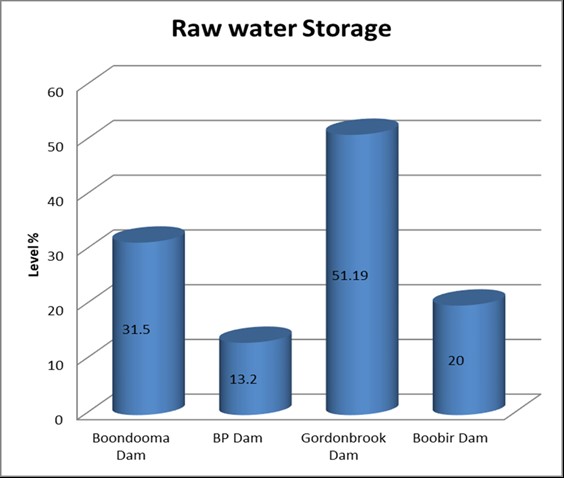South Burnett Water Security and Public Health
Mayor Brett Otto has put water security and public health in the South Burnett at the top of Council’s priorities. Council has been working collaboratively with the Queensland Government to review the level of water security across our urban supply networks particularly in relation to drought management and future demand.
The recent release of the Kingaroy Regional Water Supply Security Assessment has identified significant risks to water security particularly in relation to Kingaroy urban supply due to exahaustion of annual allocation. In addition, the current level of Gordonbrook poses a significant public health risk if Council temporarily lost access to Boondooma Dam for any period of time.
Towns and villages within the South Burnett Regional Council require reliable surface water sources to provide both potable and non-potable water supplies. The South Burnett region provides a diverse and rich agricultural area, which is critical to the local, state and national economy. Whilst drought continues to cause significant impact on all water users, the ability for both Council and agricultural industries to access additional water has become critical for public health and economic security.
Council currently sources its primary water from Boondooma Dam, Bjelke Peterson Dam, Gordonbrook Dam and underground bores. Potable supplies are currently provided from these sources to Kingaroy, Nanango, Wondai, Murgon, Proston, and Blackbutt. In addition, Council currently uses its water allocation from Boondooma Dam to supply the Toowoomba Regional Council Town of Yarraman. Kingaroy currently sources its raw supply from Boondooma Dam and Council owned Gordonbrook Dam. The water supply is usually blended 70:30, and the Gordonbrook content is increased from 30% to 100% when the Tarong Pipeline from Boondooma is down for maintenance.
Council with the support of the Queensland Government and the Australian Government has a number of critical water planning programs underway to develop strategies for water security and sustainability over both the short and long term. These programs include:
- Maturing the Infrastructure Pipeline Program (MIPP)
- Kingaroy Regional Water Supply Security Assessment (RWSSA)
- Burnett Feasibility Study – National Water Infrastructure Development Fund
The RWSSA shows that at the current annual demand of approximately 1400 ML/annum, water supply failures in the Kingaroy System may occur once in every 13 years. Further, by 2029/30 and including the projected pork processing growth related demand, the likely water supply failure rate increases to close to 1 in 4 years with an annual consumption of approximately 1800 ML/annum.
The probability of water scheme failure would continue to be exacerbated by a reduction in high priority allocation from Boondooma Dam due to drought conditions. It should be noted however that water usage in the South Burnett is currently at a minimal average of 130 - 140 litres/per person/per day, one of the lowest per capita rates within Queensland.
The current level of Gordonbrook Dam poses a possible public health concern with the dam fast approaching 50% capacity. The water quality in the Kingaroy supply is largely determined by the blend ratio of Gordonbrook to Boondooma, with Gordonbrook being substantially poorer quality particularly with Trihalomethanes (THMs) precursors, including Bromide. During periods of 100 percent supply from Gordonbrook only (which is necessitated due to Boondooma - Tarong Pipeline shutdowns), South Burnett Regional Council proactively informs the Kingaroy Base Hospital and local Dialysis patients, due to the potential that water quality can fail to meet minimum health based standards for these users. The overall water quality in Gordonbrook is in rapid decline due to the dry conditions and water levels and in particular the inorganic Bromide and blue green algae.
Water quality issues will continue to increase as water levels decrease in Gordonbrook Dam with Council unlikely to treat water to Australian Drinking Water Quality Guidelines (ADWQG). Should Kingaroy continue to use Gordonbrook Dam water either in blend or sole source, corresponding reportable health THM exceedances could occur and there is an imminent risk of a public health warning being issued.
Council requires an additional permanent 1500 - 1800 ML transfer of high priority water from Boondooma Dam. The increased allocation would significantly reduce the public health risks caused by high THM’s by reducing the reliance on Gordonbrook Dam. The additional allocation would give the South Burnett region water security and reliability that is required to protect current employment and enable economic growth through developing industries.
If Council was to receive an increased allocation, Council would be able to proceed with the development of additional onsite storage at Gordonbrook Water Treatment Plant to store Boondooma water.
The water security for Kingaroy would increase from around 1 in 13 years failure occurrence to around 1 in 280 years or better with the acquisition of additional allocation.



